Sugarcane is a perennial grass grown primarily for its stem (cane), which produces sucrose. The Sugarcane leaves grow from the nodes of the stem, divided into nodes and internodes. On either side of the stem, there are two rows of leaves. Tuberous and blade-like leaves surround the stem, with thicker centers than margins.
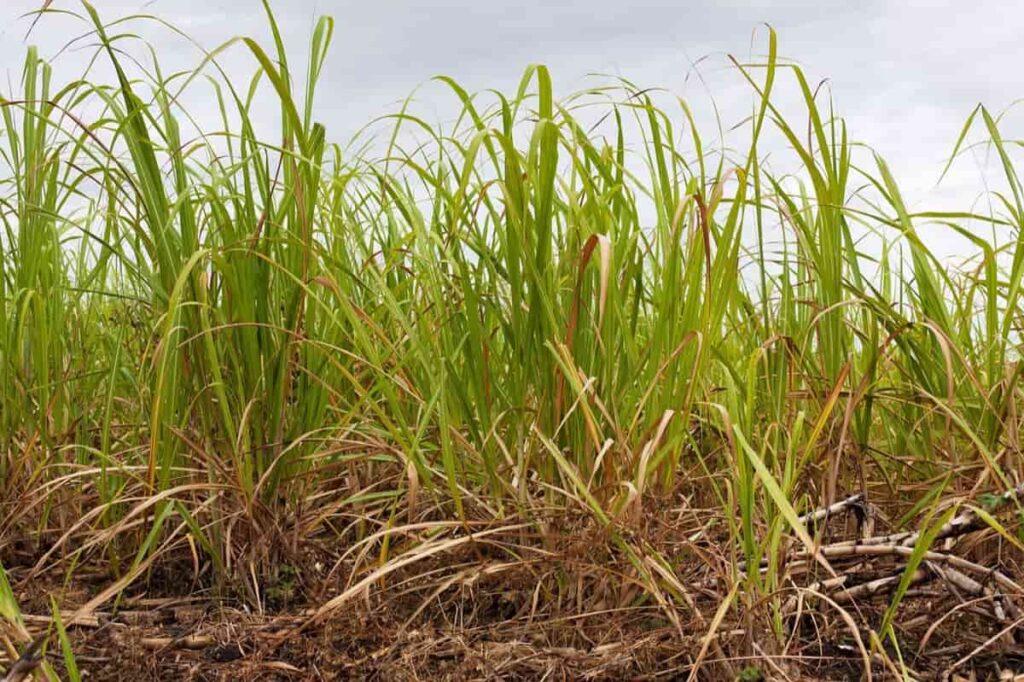
An inflorescence of Sugarcane consists of two spikelets and seeds protected by silky hair-covered husks (glumes). On the inflorescence, two flowers are produced. It can grow up to 6 meters tall, and once harvested, its stalk will regrow, allowing it to live for between 8 and 12 years. Originating from New Guinea, Sugarcane is also called noble cane.
Pest and disease management in Sugarcane
Red rot
It is caused by a fungus called Colletotrichum falcatum Went and is the most destructive disease of Sugarcane. Every part of the plant above ground is affected by the disease. The red rot disease, called Sugarcane cancer, can potentially wipe out entire standing crops. Infection can result in a 29 percent reduction in Sugarcane’s weight, which leads to poor-quality cane. Diseased cane has up to a 25% reduction in sucrose compared with a healthy cane.
Symptoms
- With the progression of the disease, the leaves gradually wither downward. It is usually the third or fourth leaf from the top that is damaged, and eventually, the entire crown wilts and declines.
- As the inner part of the Sugarcane eventually dries out, the cane shrinks and loses weight. At this point, the fungus begins to grow on the rind, often slightly below or above the nodes.
- Infected canes produce an alcoholic or acidic starchy odor when split open and show reddish spots. The red rot attack begins in September and lasts until October.
- The leaves of the affected canes change color from green to orange and then yellow in the third or fourth leaf, and then they begin to dry from bottom to top.
- There are reddish spots on the backside of the leaf midrib if fungal microorganisms enter the leaf’s sheath through the leaf midrib.
In case you missed it: Sugarcane Farming in the USA: How to Start, Production States, Ideas, and Tips
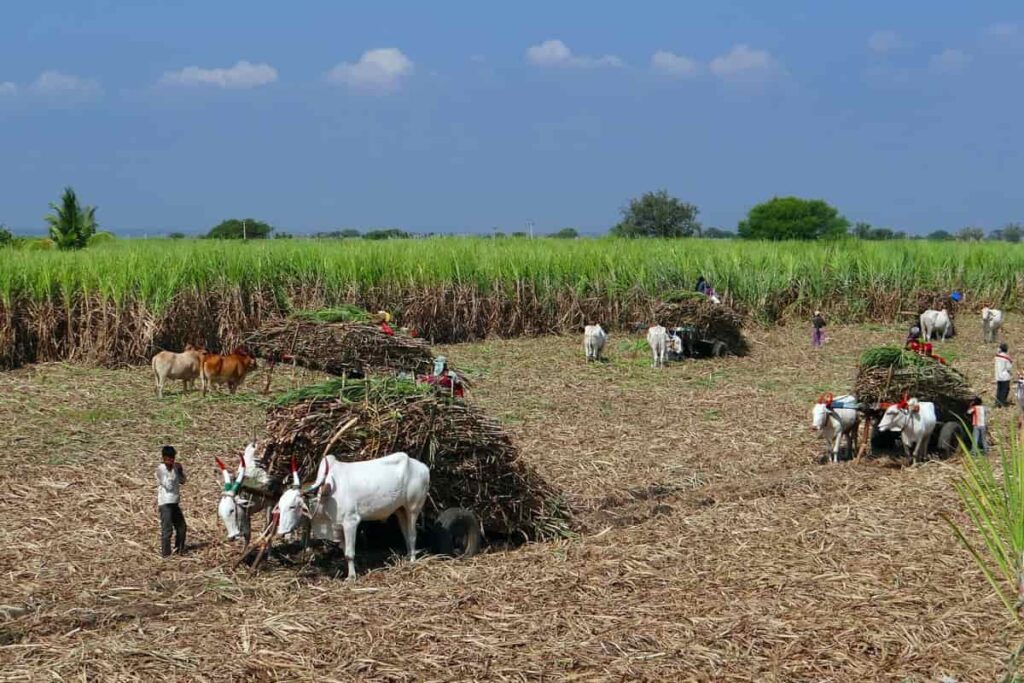
Chemical control and management methods
- Controlling the disease is most effective by planting resistant sugar cane varieties.
- Reduce inoculum levels by removing crop debris from the plantation and removing diseased plants.
- Possibly reduce the occurrence of the disease by harvesting the seed pieces and placing them in hot water before planting.
- Use Carbendazim 50 WP at 0.5gm in 1 liter of water or Carbendazim 25 DS at 1gm in 1 liter of water along with a Urea of 2.5 kg in 250 liters of water before planting.
- Infected setts can almost be eliminated by dipping setts in fungi-toxic chemicals for 18 minutes at 52°C.
Wilt
Sugarcane wilt is caused by the fungus Cephalosporium sacchari. Symptoms of the disease mostly appear after the growth phase has ended. There is a significant reduction in yield in severe cases. In the months following or during the monsoon, the plants display symptoms. Fungi enter through wounds caused by other pests such as root borers, termites, scales, and mealybugs. When stressed by biotic factors such as drought and waterlogging, plants are vulnerable to wilt infections. Moisture stress, high temperatures, and low humidity reduce plant resistance to wilt.
Symptoms
- From the base up, the leaves turn yellowish-green, lose their firmness, and eventually dry out.
- The crowns turn white or have a yellowish midrib surrounded by pale green blades.
- Affected canes have hollow internodes, lighter weights, and stunted growth, but nodes and buds are unaffected.
- Dark red to purple internal tissue extends just above the node’s growth ring in longitudinal cuts.
Chemical control and management methods
- Ratooning in diseased fields should be avoided, and seed material should come from disease-free plots.
- Burn the trash and stubbles in the field and grow coriander or mustard as a companion crop.
- In 0.15% Emisan or 0.05% Carbendazim for 15 minutes, or 40 ppm Boran or Manganese for 10 minutes, soak the setts for 10 minutes.
- Before planting, set up a Carbendazim 50% WP treatment
- For the root zone area, apply Carbendazim 50% WP at 2 grams per liter of water, followed by the same treatment at 15-day intervals.
Grassy shoot
It takes nearly two months for the disease to appear after planting. Plant phytoplasmas are responsible for causing the disease. Phloem cells of infected plants display two types of bodies. Spherical bodies measure 300 to 400 nm, and filamentous bodies measure 30 to 53 mm. Diseased setts and cutting knives are the primary sources of phytoplasma spread. Secondarily, the pathogen is transmitted by aphids such as Rhopalosiphum maydis, Melanaphis sacchariand, and Melanaphis idiosacchari.
In case you missed it: Top 24 Steps to Boost Sugarcane Yield: How to Increase Production, Size, and Quality
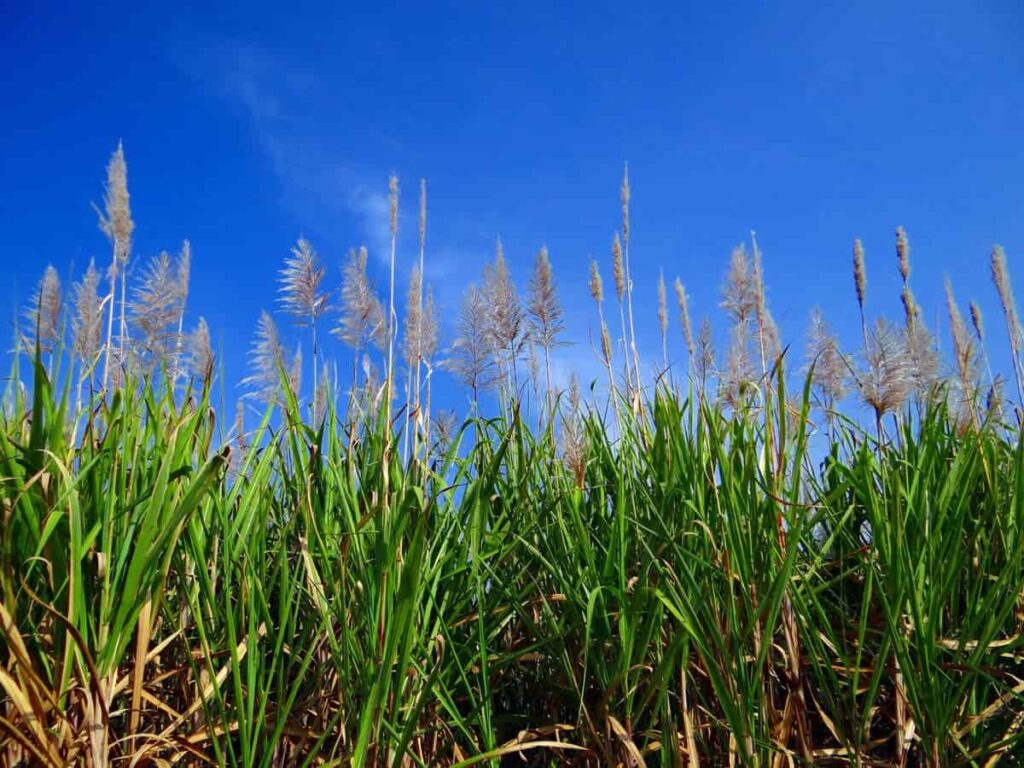
Symptoms
- Affected shoots produce numerous lanky tillers at the base. As the leaves become pale yellow to completely chlorotic, they become thin and narrow.
- As a result of premature and continuous tillering, the plants appear bushy and grass-like.
- A premature proliferation of auxiliary buds occurs in the affected clumps.
- If canes form in the affected clumps, they are thin with short internodes with aerial roots at the lower nodes. These canes usually have papery, abnormally elongated buds.
Chemical control and management methods
- It is not possible to treat this disease directly. However, controlling aphids, the primary vectors of Grassy shoots in Sugarcane, is still possible. Soft insecticidal soap solutions or oil-based solutions can be used in the case of mild infestations.
- If possible, consider integrating preventive measures with biological treatments. Insecticides can be used if aphids or leafhoppers are present in critical numbers. Sprays based on Dimethoate @ 1 ml /l water or Methyl-demeton @ 2 ml /l water can be applied twice per month.
Smut
A significant loss in productivity and profitability is caused by Sugarcane smut caused by the fungus Sporisorium scitamineum worldwide. This fungus produces airborne teliospores that can travel long distances and survive hot and dry conditions for over six months.
Symptoms
- From the growing point of the canes, a whip-like structure is produced that is 25 to 150 cm long
- An enclosing membrane encloses a mass of black powdery spores on the whip.
- A thin cane with elongated internodes becomes shorter with time.
- Particularly in ratoon crops, there is abundant sprouting of lateral buds with narrow, erect leaves
Chemical control and management methods
- For 10 minutes, set up treatment with Triadimefon at 1 gm in 1 liter of water or Carbendazim at 1 gm in 1 liter of water.
- Utilize a small hand-held sprayer to apply a 10% solution of glyphosate to infected plants.
- When the problem is severe, spray glyphosate (360 grams per liter) on the entire block at a rate of 5-7 liters per hectare.
In case you missed it: Best Fertilizer for Sugarcane: Organic, Biofertilizers, NPK, Compost Manure, and Schedule
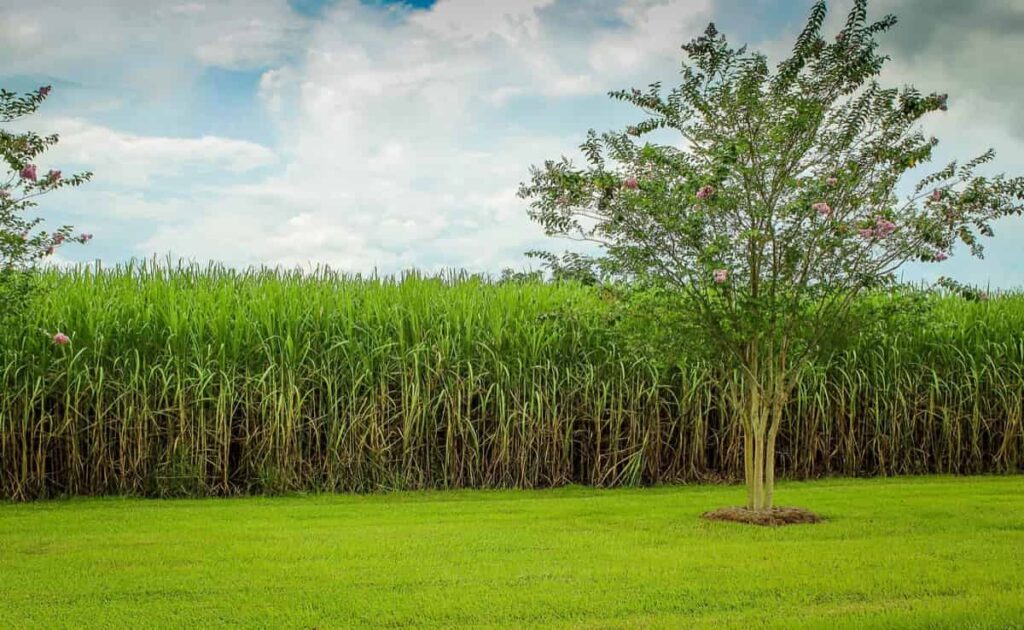
Red-striped disease
Pseudomonas rubrilineans cause this disease. Initially, this bacterium spreads through infected canes, rain splashes, irrigation water, and insects. Normal plant functions may be impaired if parenchymatous cells become infected. Additionally, these hosts may provide the pathogen a means for perpetuation and spread.
Symptoms
- Initially, the disease appears on the basal part of the young leaf. Stripes appear as long, narrow chlorotic streaks that become reddish brown after a few days. Parallel to the midrib, these stripes are 0.5-1.0 mm wide and 5-100 mm long.
- Yellowish stripes develop, becoming reddish brown, and whitish flakes spread to growing points of the shoot.
- It is possible for rotting to begin at the tip of the shoot and spread downwards.
- There is a cavity in the center of the core, which is discolored to reddish brown. There is a foul and disgusting smell in badly affected fields.
Management methods
- Managing this disease of Sugarcane is a complex task. Plants affected by the disease should be removed and burned as soon as they are discovered. By systematically destroying the diseased plants, the incidence of the disease is reduced.
- However, growing resistant varieties is the best way to control the problem.
Rust
There is a fungus known as Puccinia kuehnii that causes this disease. It is spread by rust that produces microscopic, light, and hardy spores, easily dispersed by wind and water splash. As well as plant residues in the soil, the spores survive. Summer and early autumn are the best times to observe the disease because of the warm, wet, and humid conditions. More mature cane, usually over six months of age, are usually infected. Continual cloudiness and high wind speeds exacerbate the disease.
Symptoms
- Small, elongated yellowish spots on both surfaces of leaves are the earliest signs of common rust.
- Spots become larger, mainly in length, and turn red-brown to brown as they age. A pale yellow-green halo surrounds the lesions.
- Common rust causes numerous lesions on leaves, resulting in an overall brown or rusty appearance.
- A large, irregular necrotic area results from these lesions and usually results in the premature death of the leaf. The number of live leaves per plant can be seriously reduced in such situations.
Chemical control and management methods
- It was found that both propineb and mancozeb were effective against rust at 0.25% and 0.20%, respectively. Just after rust pustules appear on the foliage, spray either of the fungicides three times within 15 days.
- An application of triazole or strobilurin, or pyraclostrobin fungicide at three gms /liter of water is recommended
Yellow leaf disease
When infected with the Sugarcane yellow leaf virus, it causes stunted cane growth, discolored leaves, and a bunchy plant appearance. As the season progresses, yellowing expands outward from the leaf midrib into the leaf blade until it can be seen from a distance as a general yellowing of the leaves. In mature cane, it is most noticeable.
In case you missed it: Organic Sugarcane Farming, Production Practices
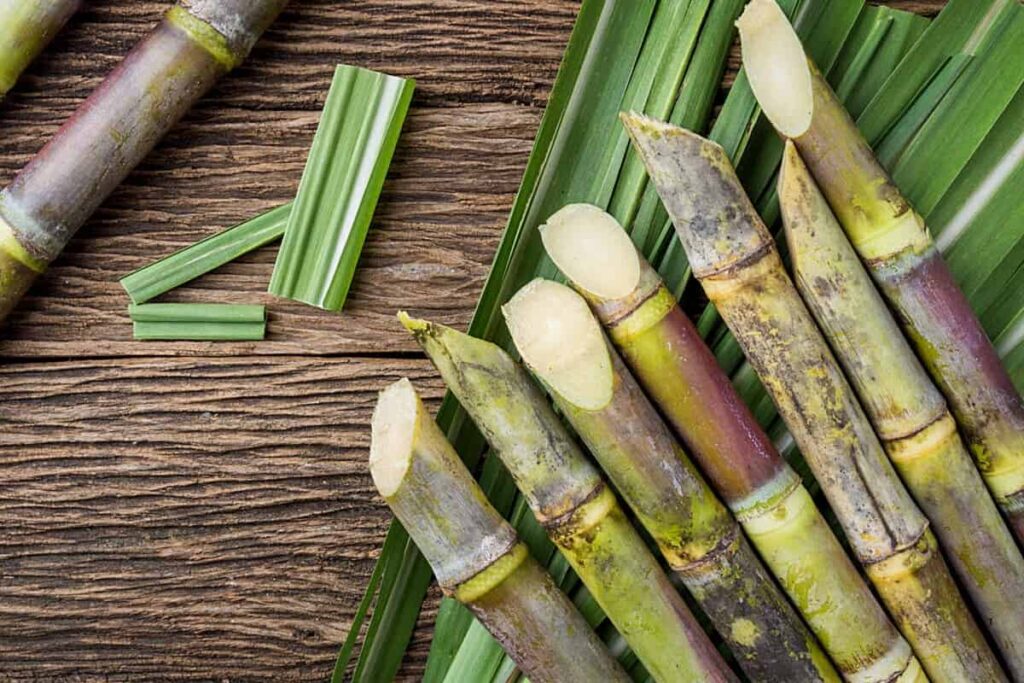
Severe infection causes the spindle to dry along with the leaves, and the top appears bunchy. Sometimes a reddish discoloration can be observed. Insect damage, plant stress, or water shortage could also be contributing factors.
Chemical control and management methods
- Malathion (0.1%) and Dimecron (0.2%) can control the secondary transmission of the disease by insect vectors.
- Carbofuran at 2.0 kg/ha or phorate at 6.0 kg/ha can be applied to the soil
- During September and October, spray Malathion at 1.5 kg/ha after removing dry leaves.
Insects & pests in Sugarcane
Early shoot borer
Early shoot borer damage can yield losses of up to 35%. During the early growth stages of the crop, before internode formation, the pest attacks the crop. When the dead hearts are crushed, the base of the dead heart gets rotten and emits an offensive odor. As soon as the pest kills one shoot, it migrates to another. In years of scant rainfall, the crop is vulnerable to pest attacks when temperatures remain high, and relative humidity is low.
Biological control
- The Granulosis virus should be applied 1.5 x 135 IBS / ha twice on 35 and 50 DAP and teepol.
- A tachinid parasite like gravid females of Sturmiopsis inferens should be released at 125 per acre.
Chemical method
A mixture of carboryl and sevidol 4% G (12.5 kg) and carbofuron 3% G (32.5 kg) is intended for soil applications. Following the granular application with irrigation is essential as soon as possible. For best results, use a high-volume sprayer in combination with chlorpyriphos 1000 ml and a sticker like Teepol (250 ml / 500 liters of water) to ensure that the solution sticks to the crop’s surface.
Internode borer
Stem-boring insects, such as the internode borer, are serious Sugarcane, maize, and sorghum pests. Its caterpillars damage the plants by tunneling inside the stems of these plants. As soon as they feed on the young leaves of their hosts, Sugarcane internode borer caterpillars cause damage to their hosts. A Sugarcane internode borer moth has a yellow-brown body with a wing span of 24 to 36 mm.
Young, tightly rolled leaves are eaten by these insects, resulting in small, scattered “shot holes” on the leaves when they unfurl. Leaf surfaces can also be transformed into small, transparent window panes when caterpillars feed on the leaf surfaces. After feeding on the plant’s growing points, the caterpillars produce dead hearts (the youngest yet unfolded leaves wilt and die).
Biological control
- Trichogramma chilonis is released every two weeks from the fourth to the tenth month at a rate of 2cc/ha.
- The conservation of Telenomus dignus, an egg parasitoid
- At a density of 2500 pregnant females per hectare, Cotesia flavipes is released
Chemical control
- Biological treatments should be considered if they are available, as well as preventive measures.
- During the growing season, spray monocrotophos, a contact insecticide, fortnightly.
- If the damage is severe, apply 30 kg of carbofuran 3G granules to the soil.
Whiteflies
A severe outbreak of whiteflies can be caused by waterlogging and excess nitrogen use. During monsoon season, droughts and dry spells also promote the growth of this pest. More varieties are susceptible to this pest, with broad leaves and long stems. As a result of the whitefly infestation, the cane growth is retarded, and the sugar content is reduced. A cane yield loss of 23.4% and a loss of 2.9% units of sucrose occurs at 80% leaf infestation.
- The leaves turn yellow and later become pale
- A purple or pinkish color is present on the leaf and gradually dries out.
- Black and white dots can be seen on infested leaves.
- It can look like a fiery appearance in severe cases
- The plant shows prolonged growth
Biological method
- Redistribution and conservation of the parasitoids Amitus minervae and Encarsia isaaci
- Using Aschersonia placenta as an entomopathogenic fungus
Chemical method
- Spray fenitrothion 50 EC at 2 liters per hectare (1000 liters of spray fluid)
- A spray fluid of 750 liters should be used to spray thiamethoxan 25 WG at 125 grams per hectare.
- Spray 2 grams of acephate per liter of water. Spraying must be repeated after a month to kill nymphs emerging from eggs
- Use a hand sprayer to apply chlorpyriphos at a rate of 1250 lit spray fluid
In case you missed it: Sugarcane Seed Germination, Time, Temperature, Process
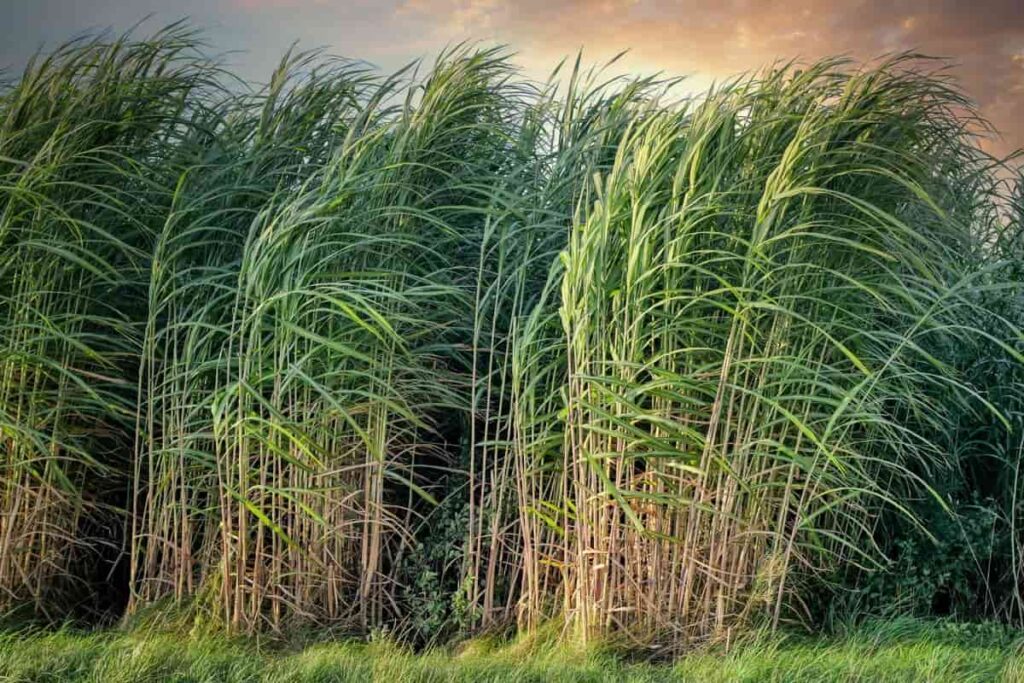
Sugarcane woolly aphids
Pests like woolly aphids have profuse white woolly coatings around them. Many people mistake it for a mealybug. There is a white powder on the ground and leaves, which confirms the presence of aphids. Without control, it can spread quickly and affect yields by 20 percent. Nymphs and adults of the aphid remain on the undersurfaces of leaves and feed on sap. As a result of their voracious appetite, the pests produce honeydew by converting excess sugar. Sooty mold fungus will grow as a result of honeydew secretion.
- The underside of a leaf is covered with a large number of white-colored nymphs and adults
- From the tip along the margins, the leaves are yellow and dry
- The leaves become brittle and dry thoroughly.
- As a result of excessive honeydew secretion, sooty mold develops.
- The wooly matter is deposited on the ground/soil.
Biological control
- Predators Dipha aphidivora, Micromus igorotus, Eupeodes confrater, and parasitoids Encarcia flavocutellum need to be conserved
- Multiplication and release of D aphidivora and redistribution of E flavoscutellum
Chemical control
| Chemical compound | Dosage |
| Acephate 75 SP | 2 gms/ liter |
| Monocrotophos 36 EC | 2 ml/ liter |
| Rogor 30 EC | 2 ml/ liter |
Termites
Light soils are particularly susceptible to this problem. During the standing crop, there are characteristic semi-circular feeding spots on the margin of the leaves, which are caused by poor germination of the setts (after planting). It is possible to pull out the entire shoot once it dries up. Setts are hollow and filled with soil inside. Mud fills the rind, and the cane collapses when disturbed. An adult is a cream-colored insect with a dark head that resembles an ant. The outer leaves are first yellowed and dried, then the inner leaves follow
Biological control
- The conservation of the parasitoids Epiricania melanoleuca, Parachrysocharis javensis, and Dryinus pyrillae
- Release and multiplication of E. melanoleuca
- An application of the entomopathogenic fungus Hirusutella citriformis
Chemical control
| Chemical compound | Dosage |
| Chlorpyriphos 20 EC | 5 liter/ha as sett drench |
| Imidacloprid | 4 ml/10 liters of water as a soil drench |
| chlorantraniprole 18.5 SC | 500-625 ml with 500 liters of water/ha |
Conclusion
In recent years, disease diagnostic testing methods have made disease management more accessible. Combined with increased quarantine and protection measures, fungicides, breeding-resistant varieties, and ongoing monitoring of potential threats, diseases can be minimized. Good farm management practices are crucial to managing Sugarcane pests using an Integrated Pest Management approach.
- Economical Aquaculture: A Guide to Low-Budget Fish Farming
- 15 Common Planting Errors That Can Doom Your Fruit Trees
- How to Make Houseplants Bushy: Effective Tips and Ideas
- Innovative Strategies for Boosting Coconut Pollination and Yield
- Pollination Strategies for Maximum Pumpkin Yield
- The Complete Guide to Chicken Fattening: Strategies for Maximum Growth
- Natural Solutions for Tulip Problems: 100% Effective Remedies for Leaf and Bulb-Related Issues
- Revolutionizing Citrus Preservation: Towards a Healthier, Greener Future
- Natural Solutions for Peony Leaf and Flower Problems: 100% Effective Remedies
- Maximizing Profits with Avocado Contract Farming in India: A Comprehensive Guide
- Natural Solutions for Hydrangea Problems: 100% Effective Remedies for Leaf and Flowers
- The Ultimate Guide to Choosing the Perfect Foliage Friend: Bringing Life Indoors
- From Sunlight to Sustainability: 15 Ways to Use Solar Technology in Agriculture
- The Ultimate Guide to Dong Tao Chicken: Exploring from History to Raising
- The Eco-Friendly Makeover: How to Convert Your Unused Swimming Pool into a Fish Pond
- Mastering the Art of Delaware Chicken Farming: Essentials for Healthy Backyard Flocks
- 20 Best Homemade Fertilizers for Money Plant: DIY Recipes and Application Methods
- How to Craft a Comprehensive Free-Range Chicken Farming Business Plan
- Brighten Your Flock: Raising Easter Egger Chickens for Beauty and Bounty
- How to Optimize Your Poultry Egg Farm Business Plan with These Strategies
- Subsidy for Spirulina Cultivation: How Indian Government Schemes Encouraging Spirulina Farmers
- Ultimate Guide to Raising Dominique Chickens: Breeding, Feeding, Egg-Production, and Care
- Mastering the Art of Raising Jersey Giant Chickens: Care, Feeding, and More
- Ultimate Guide to Raising Legbar Chickens: Breeding, Farming Practices, Diet, Egg-Production
- How to Raise Welsummer Chickens: A Comprehensive Guide for Beginners
- How to Protect Indoor Plants in Winter: A Comprehensive Guide
- Ultimate Guide to Grow Bag Gardening: Tips, Tricks, and Planting Ideas for Urban Gardeners
- Guide to Lotus Cultivation: How to Propagate, Plant, Grow, Care, Cost, and Profit
- Agriculture Drone Subsidy Scheme: Government Kisan Subsidy, License, and How to Apply Online
- Ultimate Guide to Raising Araucana Chickens: Breed Profile, Farming Economics, Diet, and Care
- Bringing Hydroponics to Classroom: Importance, Benefits of Learning for School Students
- Ultimate Guide to Raising Polish Chickens: Breed Profile, Farming Economics, Diet, and Care
- Ultimate Guide to Raising Australorp Chickens: Profile, Farming Economics, Egg Production, Diet, and Care
- Silkie Chicken Farming: Raising Practices, Varieties, Egg Production, Diet, and Care
- Sussex Chicken Farming: Raising Practices, Varieties, Egg Production, Diet and Care
- Homemade Feed Formulations for Livestock: Discover Cost-effective Starter to Finisher Feed Recipes